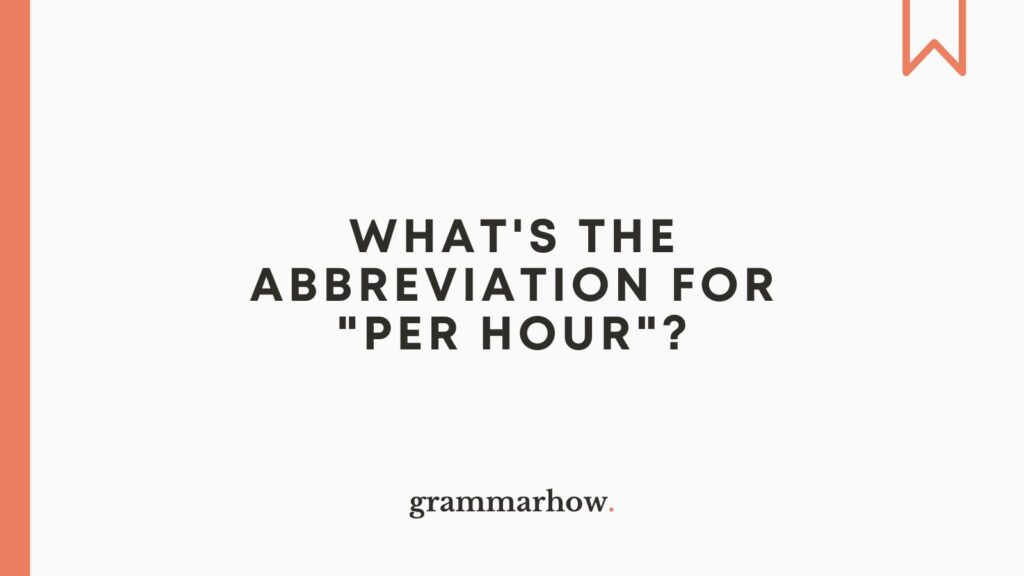“Per hour” is long-winded, and you might want to avoid using it. That’s why you’ve come looking for an abbreviation, as it will save you a few characters in your writing.
This article will explain how to abbreviate “per hour” appropriately. We’ve gathered the best abbreviations to help you.
What’s the Abbreviation for “Per Hour”?
You can abbreviate “per hour” as “p/h,” “p/hr,” “/hr,” and “ph.” These abbreviations are all correct. You should choose one and stick to it in written contexts to keep your style uniform. Every abbreviation comes after a number or a unit (i.e., “$7 p/h” or “30 mph”).
Here are some examples demonstrating how each one works:
- I only make $5 p/h at my workplace.
- You told me he offers $17 p/hr, but I haven’t received that.
- It will only be for $6/hr. Do you mind working at that rate?
- We traveled at 30 mph.
Keep reading to learn all about the correct abbreviations. We’ll share some more examples of each to help you understand when to use them.
P/h
“P/h” is a very common abbreviation for “per hour.” You will often find “p/h” referring to salary per hour or your pay rate.
The slash helps to differentiate between “per” and “hour.” It shows that they are separate words, which might help to make things clearer for the reader.
For instance:
- The job advert says I can make $10 p/h, but I’m not sure if I want to earn that little.
- It’s only for $20 p/h, so I’ll see what else is out there.
“P/h” gives you a good way to show your dollars per hour (or other currencies, based on where you live). It’s one of the most obvious ways to abbreviate “per hour.”
P/hr
“P/hr” is a slightly longer way to abbreviate “per hour.” You can use it because “hr” is a clear way to abbreviate “hour.” Some writers like to leave the “r” in the abbreviation to avoid any confusion with other words abbreviated to “h.”
Here are a few examples to help you with it:
- We don’t make much more than $15 p/hr here. So, will that work for you?
- I heard they were going to sprint at about 20 miles p/hr. That’s inhuman!
/hr
“/hr” is another abbreviation choice. You don’t have to include “P” in the abbreviation because the slash already suggests you mean “per.”
Technically, “P” in an abbreviation with a slash is redundant. That’s why some prefer the “/hr” abbreviation to remove potential redundancies.
These examples should show you how it works:
- We looked into working for them, but they only offered £7/hr. It’s not enough!
- They do it for $30/hr. Can you afford that?
Since you do not include “P,” the slash comes directly after the number. There should be no space between the number and the slash.
Ph
“Ph” is the most common abbreviation when working with distances or speeds. You’ll often see “miles per hour” abbreviated to “mph.”
You don’t need to use slashes when working with distances. “Mph” is more logical and clear than “m/p/h,” which is why it’s more popular amongst native speakers.
Here are some examples to help you understand it:
- We wanted to go at 360 mph, but they told us that was too much.
- It’s only a 40 kmph zone. We have got to be careful how we travel.
If you do use it for “mph” or “kmph,” you should include “ph” after the other units. For instance, “miles” becomes “m,” so you should write “mph” to indicate that “miles” comes before “per hour.”
Conclusion
You can use “p/h” or “p/hr” when referring to salaries. They are the most common abbreviations to show monetary values.
“/hr” is a useful choice if you want to remove the redundancy from “p/hr.” “P” and “/” mean the same, so you don’t need both.
“Ph” without any slashes is a great abbreviation for distances or speeds. You can use it alongside other unit abbreviations like “miles” (i.e., mph).

